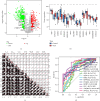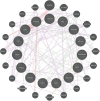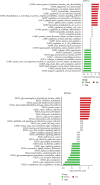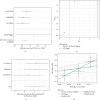Immune Regulation and ECM-Related Pathway Enrichment Reveal ATP2A3 as a Prognostic Biomarker for Nonspecific Orbital Inflammation: An Integrated Machine Learning and Mendelian Randomization Analysis
- PMID: 40548296
- PMCID: PMC12181670
- DOI: 10.1155/mi/7061507
Immune Regulation and ECM-Related Pathway Enrichment Reveal ATP2A3 as a Prognostic Biomarker for Nonspecific Orbital Inflammation: An Integrated Machine Learning and Mendelian Randomization Analysis
Abstract
Background: Nonspecific orbital inflammation (NSOI) is a heterogeneous inflammatory disorder of the orbit with an unclear etiology. ATP2A3, a key regulator of calcium homeostasis in the endoplasmic reticulum (ER), may play a pivotal role in NSOI pathogenesis. Its potential as a diagnostic biomarker merits thorough investigation. Methods: Differentially expressed genes (DEGs) common to two GEO datasets (GSE58331 and GSE105149) were intersected with immune-related genes from the ImmPort database, yielding 89 candidates. ATP2A3 was prioritized using machine learning (ML) approaches, including LASSO, support vector machine (SVM)-RFE, and weighted gene coexpression network analysis (WGCNA). Functional enrichment was assessed using GSEA and GSVA based on genes co-expressed with ATP2A3. Immune microenvironment characteristics were evaluated using CIBERSORT and ESTIMATE. Expression of ATP2A3 was validated in GSE105149. Results: Fifteen hub genes were identified, with ATP2A3 strongly linked to immune-related pathways. Genes positively correlated with ATP2A3 were enriched in sensory perception and extracellular matrix (ECM) organization. Immune infiltration analysis revealed a positive association between ATP2A3 expression and memory B cells, M2 macrophages, resting mast cells, monocytes, and regulatory T cells (Tregs), while naive B cells and plasma cells were negatively associated. ATP2A3 exhibited significant diagnostic potential for distinguishing NSOI. Conclusions: In the context of NSOI, we identify ATP2A3 as a novel contributor to immune-driven pathogenesis. Its significant dysregulation in NSOI tissues relative to healthy controls underscores its potential as a prognostic marker within the inflammatory microenvironment.
Keywords: ATP2A3; Lasso regression; Mendelian randomization; autoimmune inflammatory disorder; nonspecific orbital inflammation (NSOI).
Copyright © 2025 Zixuan Wu et al. Mediators of Inflammation published by John Wiley & Sons Ltd.
Conflict of interest statement
The authors declare no conflicts of interest.
Figures









Similar articles
-
Integrated multiple machine learning and Mendelian randomization reveal LTF gene as a prognostic biomarker for nonspecific orbital inflammation.BMC Pharmacol Toxicol. 2025 Aug 4;26(1):143. doi: 10.1186/s40360-025-00980-6. BMC Pharmacol Toxicol. 2025. PMID: 40760708 Free PMC article.
-
Gluconeogenesis related gene signatures as biomarkers for nonspecific orbital inflammation.Sci Rep. 2025 Jul 1;15(1):20819. doi: 10.1038/s41598-025-05002-3. Sci Rep. 2025. PMID: 40595959 Free PMC article.
-
Integrated machine learning and Mendelian randomization reveal PALMD as a prognostic biomarker for nonspecific orbital inflammation.Sci Rep. 2024 Oct 14;14(1):24020. doi: 10.1038/s41598-024-74409-1. Sci Rep. 2024. PMID: 39402101 Free PMC article.
-
Cost-effectiveness of using prognostic information to select women with breast cancer for adjuvant systemic therapy.Health Technol Assess. 2006 Sep;10(34):iii-iv, ix-xi, 1-204. doi: 10.3310/hta10340. Health Technol Assess. 2006. PMID: 16959170
-
Mammographic density, endocrine therapy and breast cancer risk: a prognostic and predictive biomarker review.Cochrane Database Syst Rev. 2021 Oct 26;10(10):CD013091. doi: 10.1002/14651858.CD013091.pub2. Cochrane Database Syst Rev. 2021. PMID: 34697802 Free PMC article.
References
-
- Eshraghi B., Sonbolestan S. A., Abtahi M.-A., Mirmohammadsadeghi A. Clinical Characteristics, Histopathology, and Treatment Outcomes in Adult and Pediatric Patients With Nonspecific Orbital Inflammation. Journal of Current Ophthalmology . 2019;31(3):327–334. doi: 10.1016/j.joco.2019.03.004. - DOI - PMC - PubMed
MeSH terms
Substances
LinkOut - more resources
Full Text Sources

